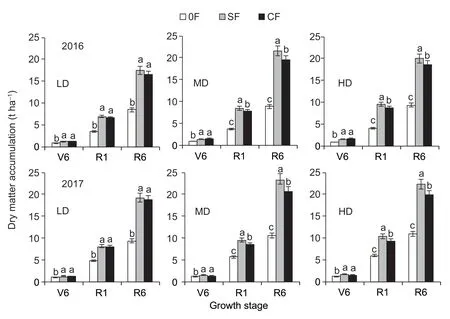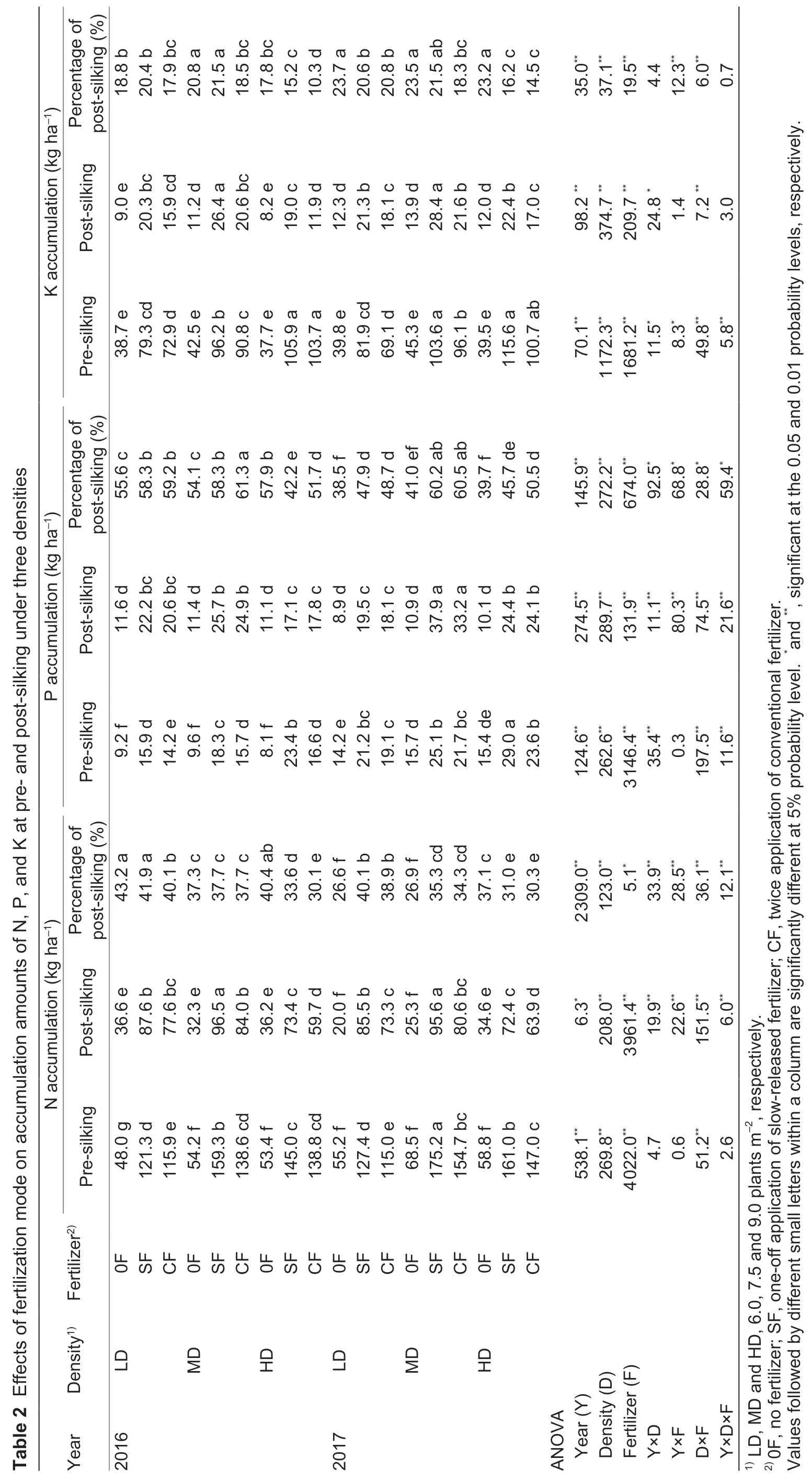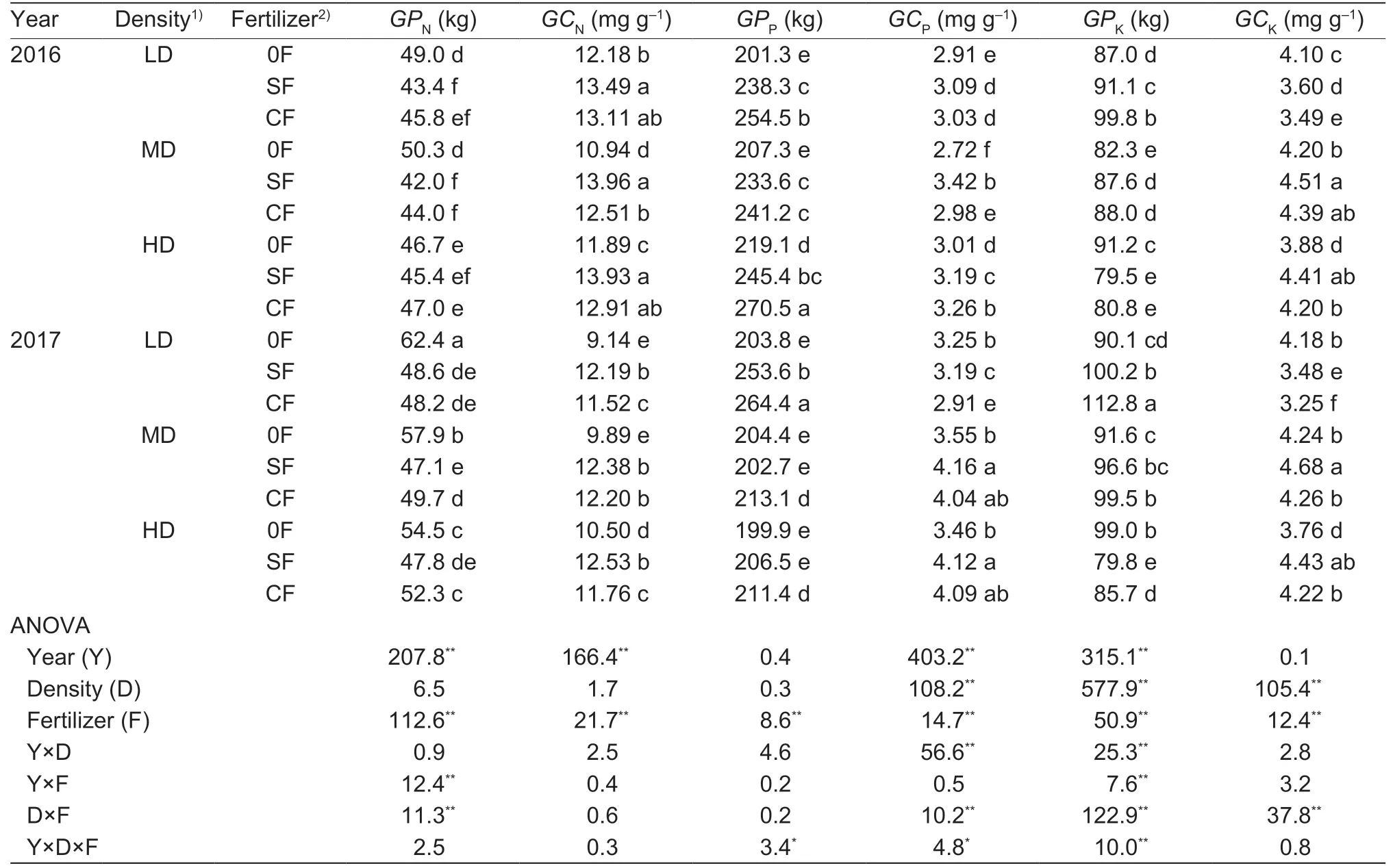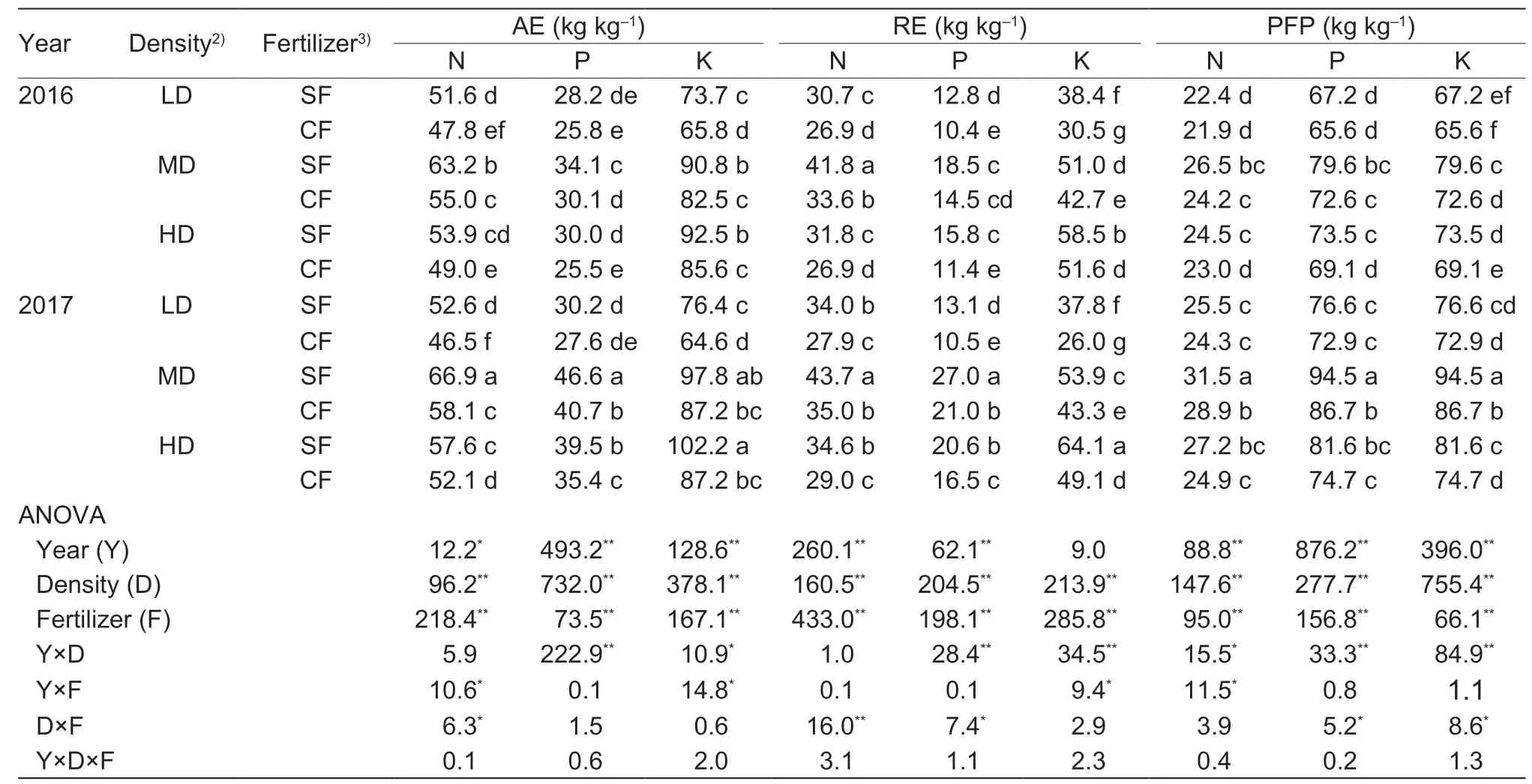N,P and K use efficiency and maize yield responses to fertilization modes and densities
2021-12-14
Jiangsu Key Laboratory of Crop Genetics and Physiology/Jiangsu Key Laboratory of Crop Cultivation and Physiology/Agricultural College,Yangzhou University/Jiangsu Co-Innovation Center for Modern Production Technology of Grain Crops,Yangzhou 225009,P.R.China
Abstract Optimal planting density and proper fertilization method are important factors to improve maize yield and nutrient utilization.A two-year (2016 and 2017) field experiment was conducted with three plant densities (6.0,7.5 and 9.0 plants m-2) and three fertilization modes (no fertilizer,0F; one-off application of slow-released fertilizer,SF; twice application of conventional fertilizer,CF). Results indicated that the grain yields and N,P and K use efficiencies under SF with the optimal planting density (7.5 plants m-2) were the highest among all the treatments in 2016 and 2017. Compared with CF,SF could increase post-silking dry matter accumulation and promote N,P and K uptake at pre-and post-silking stages; this treatment increased grain N,P and K concentrations and resulted in high N,P and K use efficiencies. Nutrient (N,P and K) absorption efficiencies and partial productivity,and nutrient (N and P) recovery efficiency in SF treatment were significantly higher than those in CF treatments under the planting density of 7.5 plants m-2. Under both SF and CF conditions,the grain yield,total N accumulation and nutrient use efficiencies initially increased,peaked at planting density of 7.5 plants m-2,and then decreased with increasing plant density. Based on the yield and nutrient use efficiency in two years,plant density of 7.5 plants m-2 with SF can improve both the grain yield and N,P and K use efficiency of spring maize in Jiangsu Province,China.
Keywords: maize,grain yield,slow-released fertilizer,nutrient use efficiency,planting density
1.lntroduction
Maize is the first major crop in China and in the world,it plays an important role in ensuring China’s food security (Li Set al.2017). Planting density and fertilizer are two of the most important cultivation measures to improve maize yield and nutrient utilization (Muelleret al.2013; Testaet al.2016;Weiet al.2019). The annual fertilizer consumption of China accounts for 35% of the global total fertilizer consumption,and excessive fertilizer application reduces crop yield and fertilizer use efficiency (Abbasiet al.2013; Menget al.2016;Ahmedet al.2017) and severely affects the agricultural and ecological environment (Lal 2013; Chenet al.2014).Increasing plant density is one of the main approaches for increasing the yield of modern maize (Antoniettaet al.2014; Testaet al.2016). However,excessive density with crowding stress reduces the capability of plants to use soil N and exerts a detrimental effect on grain yield (Tollenaaret al.2006; Yanet al.2017). Therefore,optimal planting density is an important crop management practice to improve maize yield (Zhanget al.2018).Plant nutrient uptake is closely related with total dry matter accumulation and grain yield(Setiyonoet al.2010),which is sensitive to plant density and N uptake (Ciampitti and Vyn 2011). Rational fertilization could increase nutrient accumulation during the post-silking stage,meet high yield demands and increase nutrient utilization (Menget al.2016). The soil nitrate content and N uptake of the post-silking plants with controlled-release urea are higher than those with conventional urea (Huet al.2013). The application of controlled-release fertilizer could increase maize yield and N use efficiency by increasing net photosynthesis and decreasing NH3volatilization rate (Zhaoet al.2013). The release curves of controlled-release urea in the natural field correspond well to the N requirements of maize plants,and controlled-release urea could significantly increase maize yield and N use efficiency compared with conventional urea (Genget al.2016; Zhenget al.2017).
Studies have reported grain yield in response to the combined effects of enhanced density and N supply(Boomsmaet al.2009). The interaction effects of density and N rate on maize crops have been widely investigatedviadetailed physiological analyses (Muchow 1994; Rossiniet al.2011) that mainly focused on yield or N uptake and allocation dynamics (Ciampitti and Vyn 2011,2013a,b). However,few works have attempted to compare the effects of slowreleased fertilizer combined with plant densities on N,P and K accumulation at the pre-and post-silking stages,nutrient use efficiency and grain yield with conventional fertilizer.The objectives of the present study were:(i) to determine the effects of fertilization mode and plant density on grain yield; (ii) to compare the effects of SF (one-off application of slow-released fertilizer) and CF (twice application of conventional fertilizer) on grain production per kg N,P and K (denoted asGPN,GPPandGPK,respectively) and grain concentrations of N,P and K (denoted asGCN,GCPandGCK,respectively); and (iii) to evaluate the advantage of SF on post-silking nutrient uptake and nutrient use efficiency compared with CF under three planting densities. The results could provide information for the selection of optimal planting density and fertilization strategies to improve maize grain yield and nutrient utilization.
2.Materials and methods
2.1.Experimental materials and design
A field study was conducted at the Experimental Farm of Yangzhou University,Jiangsu Province,China (32°30´N,119°25´E) in 2016 and 2017. The soil type was sandy loam (typic fluvaquents,etisols,US classification),and the average soil pH and organic matter in the tillage layer (0-20 cm) were 6.8 and 13.2 g kg-1in 2016,respectively,and 6.9 and 14.7 g kg-1in 2017,respectively. Alkali hydrolyzable N,exchangeable P and available K were 82.3,8.7 and 73.9 mg kg-1in 2016,respectively,and 85.3,10.3 and 82.2 mg kg-1in 2017,respectively. Slow-released fertilizer(N-P2O5-K2O=27-9-9),conventional compound fertilizer(N-P2O5-K2O=15-15-15) and conventional urea (N 46%)were provided by Jiangsu Zhongdong Fertilizer Co.,Ltd.(Changzhou,Jiangsu,China). Treatments were arranged in a split plot design in both years. The main plot was assigned with three plant densities:6.0 plants m-2(low density,LD),7.5 plants m-2(medium density,MD) and 9.0 plants m-2(high density,HD) plants m-2. The subplot was fertilization mode,including no fertilizer (0F),SF and CF. Three replications were performed. The fertilization amounts of N,P2O5and K2O were 405,135 and 135 kg ha-1,respectively. SF was applied at the rate of 405 kg N ha-1(P2O5and K2O were 135 kg ha-1) as basal fertilizer at the sowing stage. CF was applied at the rates of 135 kg ha-1N,P2O5and K2O as conventional compound fertilizer at sowing and the N rate of 270 kg ha-1as conventional urea at the sixth extended leaf stage (V6 stage). All plots were 10 m long and 9.6 m wide with 16 rows and row spacing of 0.4 and 0.8 m.
Maize variety Suyu 30 (SY30,HL40×YJ7),which is widely planted in Jiangsu Province,was used as the test material.Seeds were sown at a depth of 3-5 cm on March 26,2016 and March 29,2017. The harvest dates were August 6,2016 and August 9,2017. The depth of furrow fertilization was 10 cm. All weeds were controlled with a combination of pre-emergence residual herbicides and a single postemergence application at the fifth extended leaf stage (V5 stage). All maize seeds were treated in a similar manner with Acceleron™ (difenoconazole,fludioxonil,mefenoxam,and thiamethoxam),and phoxim was applied to the soil as an insecticide to control maize rootworm in each plot.
2.2.Sampling and measurements
Three plants were collected as the representative for each treatment at the V6,silking stage (R1) and maturity (R6) in the field experiment. Aboveground plants were separated into leaves and stems at V6 and R1 and into stems,leaves,cobs,and grains at R6. The samples were then dried at 80°C in a forced-air oven to a constant weight and weighed separately. After weighted,the samples were ground using a cyclone sample mill with a fine mesh (0.5 mm). The N and P concentrations of different organs were determined using the continuous-flow analysis method (Autoanalyzer-3,SEAL,Germany). K concentrations were determined using an FP-6410 flame photometer (Shanghai Precision Instrument Co.,Ltd.,China). The following parameters (Ciampitti and Vyn 2013b; Qiet al.2013; Qiuet al.2015) were calculated:
Plant N (P and K) accumulation amount (kg ha-1)=Plant N (P and K) concentration×Plant dry matter weight
Post-silking N (P and K) accumulation amount (kg ha-1)=Total N (P and K) accumulation amount at maturity-N(P and K) accumulation amount at silking stage
Grain production per kg N (P and K) (kg)=Grain weight/Total N (P and K) accumulation amount
N (P and K) absorption efficiency (AE,kg kg-1)=Total plant N (P and K) accumulation amount at maturity/Total amount of applied N (P and K)
N (P and K) recovery efficiency (RE,%)=[Total plant N(P and K) accumulation amount at maturity-Total plant N (P and K) accumulation amount at maturity in 0F treatment]/Total amount of applied N (P and K)
N (P and K) partial productivity (PEP,kg kg-1)=Grain yield in N (P and K) application treatment/Total amount of applied N (P and K)
2.3.Grain yield harvest
Thirty ears from the middle three rows of each plot were harvested at the R6 using a continuous sampling method and were used to determine yield and yield components(standard moisture content was 14%).
2.4.Statistical analysis
All data were subjected to ANOVA in the General Linear Model module of SPSS (ver.17.0,SPSS,Chicago,IL,USA).Comparisons among treatments were based on Duncan’s test at the 0.05 probability level (P<0.05). Figures were generated with the Sigma Plot 10.0 Program.
3.Results
3.1.Grain yield and yield components
Planting density,fertilization mode and their interaction had significant effects on maize yield and its components(Table 1). In 2016 and 2017,the highest grain yields(10.7 and 12.8 t ha-1) were obtained under SF application combined with MD.The actual ears increased with increasing density and were similar among three fertilization treatments. However,grain weights and grains per ear decreased under all three fertilization treatments with increasing density. Gain yields initially increased and then decreased under SF and CF with increasing density. Under LD and HD,the grain weights,numbers and yields of SF and CF were similar. Under MD,the grain yields of SF were 9.2 and 9.4% higher than those in CF in 2016 and 2017.
3.2.Dry matter accumulation
Under LD,the dry matter (DM) weights of SF and CF were similar at three growth stages and were higher than those of 0F (Fig.1). Under MD and HD,the DM weights of SF and CF were similar at V6 but those of SF were significantly higher than those of CF at R1 and R6. The DM weights of SF and CF at R6 decreased from MD to HD,and DM weights of other treatments at three stages all increased from LD to MD. The highest DM weights (21.6 and 23.5 t ha-1) were obtained under SF combined with MD at maturity in 2016 and 2017 (Fig.1).
3.3.Accumulation amounts of N,P and K at pre-and post-silking
Planting density and fertilization mode had considerable effects on the accumulation amounts of N,P and K at the pre-and post-silking stages (Table 2). Fertilization drastically increased the accumulation amounts of N,P and K at the pre-and post-silking in 2016 and 2017. The N accumulation amounts at pre-and post-silking under SF treatment combined with MD were the highest among all the treatments in 2016 and 2017. Under LD,N accumulation at the pre-and post-silking stages of SF and CF were similar but those of SF under MD and HD were significantly higher than that of CF. The post-silking N accumulation percentages were similar between SF and CF under MD and HD and those of SF were higher than that in CF under LD. Pre-silking P accumulation under SF combined with HD was the highest,and post-silking P accumulation under SF and CF combined with MD was the highest. The post-silking P accumulation percentages were similar between SF and CF combined with MD and LD and those under CF were higher than those under SF combined with HD. SF combined with MD and HD and CF combined with HD resulted in the highest pre-silking stage K accumulation,whereas SF combined with MD had the highest post-silking K accumulation in 2016 and 2017.The post-silking K accumulation percentages were similar between SF and CF under LD and it in SF were higher than that in CF under MD and HD.
3.4.GPN,GPP,GPK and GCN,GCP,GCK
Fertilization modes had significant effects onGPN,GPP,GPK,GCN,GCP,andGCK. Planting density did not affectGPN,GPPandGCN,but had significant effects onGPK,GCPandGCK(Table 3). TheGPNof SF+MD was the lowest among all the treatments in 2016 and 2017. Under LD,theGPNof SF and CF was similar but that of SF was lower than that of CF under MD and HD. TheGCNof SF under MD and HD was the highest in 2016 and 2017 and that of SF washigher than that of CF under three densities(Table 3). TheGPPof SF and CF was similar under MD and that of CF was significantly higher than that of SF under LD and HD. TheGCPof SF+MD was the highest in 2016 and 2017 and that of SF was higher than that of CF under LD and MD but were similar under HD. TheGPKof SF+HD was the lowest in 2016 and 2017 and that of SF was similar to that of CF under MD,but lower than that of CF combined with LD and HD. TheGCKof SF under MD was the highest in 2016 and 2017 and that of SF was higher than that of CF combined with MD and HD,but theGCKof CF combined with MD and HD were similar to that under LD.

Table 1 Effects of fertilization mode on grain yield and yield components of spring maize under three densities

Fig.1 Dynamic changes in plant dry matter of maize under different fertilization modes and densities. V6,the sixth extended leaf stage; R1,silking stage; R6,physiological maturity stage. LD,MD and HD,6.0,7.5 and 9.0 plants m-2,respectively. 0F,no fertilizer; SF,one-off application of slow-released fertilizer; CF,twice application of conventional fertilizer. Columns with different letters are significantly different at 5% probability level. Bars are SE (n=3).

3.5.Nutrient use efficiencies
Fertilization modes and planting densities had significant effects on AE,RE and PFP(Table 4). TheAENandAEPof SF+MD were the highest among all the treatments in 2016 and 2017. TheAEKof SF was similar between MD and HD and higher than that of the other treatments. TheAEN,AEPandAEKof SF were higher than those in CF under three densities.TheRENandREPofSF+MD were the highest,and theREKof SF+HD were the highest in 2016 and 2017. TheREN,REPandREKof SF were higher than that in CF under three densities. TheRENandREPof SF+MD were the highest in 2016 and 2017,and thePEPN,PEPPandPEPKof SF were higher than those of CF under three densities (Table 4). Grain yield had significantly positive correlations with N and P recovery efficiency but had no significant correlation with K recovery efficiency (Fig.2).

Table 3 Effects of fertilization mode on grain production per kg N (GPN),P (GPP) and K (GPK) and grain concentration of N (GCN),P (GCP) and K (GCK) under three densities
4.Discussion
4.1.Grain yield response to fertilization and density
A previous study has demonstrated that a maize planting density of 7.5 plants m-2induces optimum biomass accumulation and allocation to grains to achieve optimum grain yield and nutrient use efficiency in the North China Plain (Yanet al.2016). In our study,the highest grain yield,AEN,AEP,REN,REP,PEPN,PEPP,andPEPKwere also achieved under 7.5 plants m-2with SF. The consistency of this finding with the results of previous studies indicates that the response of maize grain yield to increasing plant density follows a parabolic curvilinear relationship (Tokatlidis and Koutroubas 2004; Yanet al.2016). Increasing density could increase total grain number and decrease grain weight in maize production (Rossiniet al.2011; Liet al.2018). In present study,the actual ears increased with increasing density and did not significantly differ among the three fertilization modes. However,the grain weight and grains per ear decreased with increasing density. Gain yields initially increased and then decreased under SF and CF with increasing density. These results are consistent with those of previous studies on controlled release fertilizer(Zhaoet al.2013; Donget al.2016).
4.2.Nutrient uptake response to fertilization and density
Ciampittiet al.(2012) demonstrated that N fertilization could drastically promote the remobilization of nutrients from vegetative organs to the grain between the vegetative stage and the reproductive stage. In present study,the highest DM was obtained under SF with MD at maturity. Planting density and fertilizer management are closely related tonutrient uptake,translocation and partitioning in maize(Ciampitti and Vyn 2011; Chenet al.2015; Menget al.2016).Aboveground N uptake increases with N rate primarily due to the increased aboveground biomass (Liuet al.2018). A close relationship among P,K and N concentrations in shoot biomass has been reported in maize (Ziadiet al.2007; Gilleset al.2012). P and K accumulation either decreases or is unaffected with increasing N application (Osborneet al.2004).In present study,fertilization significantly increased N,P and K accumulation at the pre-and post-silking stages. Planting densities and fertilization modes had significant effects on N,P and K accumulation and the percentage of post-silking accumulation. The results indicated that N accumulation at the pre-and post-silking stages under SF+MD was the highest,and the percentage of post-silking P accumulation under SF and CF with MD and LD were similar. The SF and CF treatments under HD resulted in the highest K accumulation at pre-silking stage,whereas the SF+MD had the highest K accumulation at post-silking stage.

Table 4 Effects of fertilization modes on nutrient use efficiencies of maize under three densities1)

Fig.2 Relationship between grain yield and N,P and K recovery efficiency.
4.3.Nutrient use efficiency response to fertilization and density
Nitrogen affects the grain yield and N concentration of maize,but little was known about its effect onGCPandGCK(Gilleset al.2012). Increasing N fertilization increasesGCN(Osborneet al.2004),but the effects of density and fertilization mode onGPP,GPK,GCP,andGCKhave not been investigated. In our study,theGPNof SF+MD was the lowest,whereas theGCNof SF under MD and HD was the highest and that of SF was higher than that of CF under all densities. TheGPPof SF and CF was similar under MD,and theGCPof SF+MD was the highest. TheGPKof SF+HD was the lowest,and theGPKof SF+MD was the highest. SF could promote N accumulation at the pre-and post-silking stages and had higher grain N concentration and lower grain production per kg N. These results indicated that SF application had an advantage on N translocation to grain compared with CF. This result was consistent with that of Li Get al.(2017). However,SF and CF had similar effects on P and K translocation in maize production,this may due to the one-off application of P2O5and K2O at sowing time.
The various assessments of nutrient use efficiencies were affected by the complex interaction of environment,management practice,and crop genotype (Ciampitti and Vyn 2011) and were important to environmental sustainability and profitability. Low N application often results in poor yield,whereas excessive N application reduces nutrient use efficiencies (Ciampitti and Vyn 2011). In present study,the effects of three fertilization modes on AE,RE and PFP under three densities were different. TheAEN,AEKandAEPof SF+MD were the highest,and higher than those of CF.The suboptimal and supra-optimal plant densities result in reduced yield and nitrogen use efficiency (Yanet al.2016).In our study,theRENandREPof SF under MD were the highest,and theREKof SF under HD was the highest. ThePEPN,PEPPandPEPKof SF under MD were the highest among all treatments,and thePEPN,PEPPandPEPKof SF were higher than that of CF under three densities. These results indicated that slow-released fertilizer was superior to traditional fertilizer in improving nutrient use efficiencies.The scope of this study is limited to one location and one maize variety,and it does not address plant physiology. In subsequent experiments,the advantage of SF on maize yield and nutrient use efficiency should be verified by using multiple varieties and sites and discussed based on physiological levels.
5.Conclusion
Many farmers commonly used low planting density and over-application of fertilizer in maize production. We studied N,P and K use efficiency and maize yield responses to fertilization modes and densities. The results demonstrated that slow-released fertilizer was superior to conventional fertilization in improving grain yield and nutrient use efficiencies. SF combined with a maize plant density of 7.5 plants m-2promoted pre-and post-silking N,P and K accumulation and translocation to grains to achieve optimum grain N content and high grain yield,whereas suboptimal(6.0 plants m-2) and supra-optimal (9.0 plants m-2) plant densities reduced yield and nutrient use efficiencies. Thus,we recommend the appropriate density of 7.5 plants m-2combined with SF to increase grain yield and N,P and K use efficiencies in spring maize production in Jiangsu Province.
Acknowledgements
We would like to acknowledge the financial support of the National Key Research and Development Program of China(2016YFD0300109 and 2018YFD0200703),the National Natural Science Foundation of China (31771709),the Jiangsu Agricultural Industry Technology System of China(JATS[2019]458),the High-end Talent Support Program of Yangzhou University,China,and the Priority Academic Program Development of Jiangsu Higher Education Institutions,China.
杂志排行
Journal of Integrative Agriculture的其它文章
- lnfectious disease-resistant pigs:Will they fly?
- Crop photosynthetic response to light quality and light intensity
- Alginate oligosaccharides preparation,biological activities and their application in livestock and poultry
- Genome-wide pedigree analysis of elite rice Shuhui 527 reveals key regions for breeding
- TaSnRK2.4 is a vital regulator in control of thousand-kernel weight and response to abiotic stress in wheat
- Development and characterization of new allohexaploid resistant to web blotch in peanut
